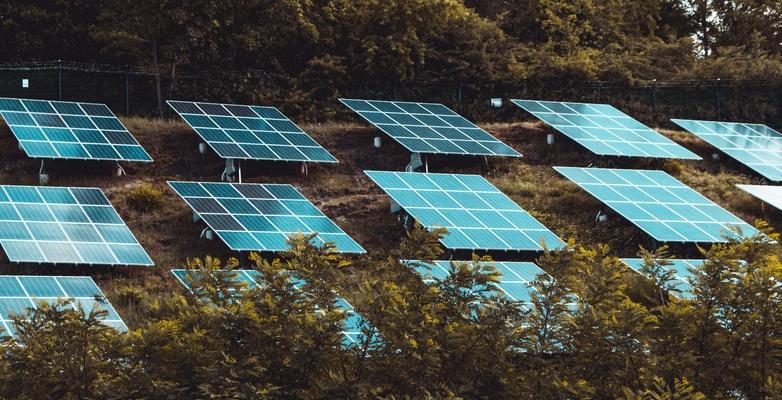
What We Mean: Community Solar
Community solar programs provide the potential for widespread access to solar energy.
Did you know that enough solar energy strikes the earth every hour and a half to power the planet for a year? Isn’t that an incredible – and useful! – fact?
It’s no wonder then that solar energy has exploded all around the world.
But how do you get in on the solar revolution if you don’t own your roof, or something else is standing in the way of you putting panels right on top of your own house? Consider a community solar project.
Community solar energy programs are sometimes referred to as “shared solar,” “community shared solar,” or “solar gardens.” They allow multiple energy consumers to share the benefits of one solar system.
Community solar projects are an especially attractive idea for households that are not able to adopt their own rooftop solar system due to constraints like a lack of home ownership or roof access, low rooftop sun exposure, and/or insufficient rooftop area for panels.
They provide the potential for widespread access to solar energy. This increased accessibility provides opportunities for lower-income households, in particular, to benefit from clean energy.
How Do Solar Panels Work Again?
A solar panel “works by allowing photons, or particles of light, to knock electrons free from atoms, generating a flow of electricity,” Live Science explains. That’s a technical way of saying that the panel’s photovoltaic cells convert the energy in sunlight to electricity (specifically, direct current (DC)). This DC electricity is then converted to alternating current (AC) by an inverter.
AC is the type of electrical current you typically use when you plug anything into a residential wall socket. If you have solar on your roof, the system’s electrical panel sends power to your lights and appliances.
With community solar, however, customers are most often getting their energy from solar panels at an off-site array.
What is Community Solar?
According to the US Department of Energy, community solar is defined “as any solar project or purchasing program, within a geographic area, in which the benefits of a solar project flow to multiple customers such as individuals, businesses, nonprofits, and other groups.”
Customers either buy or lease a portion of the solar panels in the array, and receive credit on their electricity bills for their share of the power produced.
There are many variations on the approach, but the general outline is that an entity like a utility or a community come together to purchase or develop a solar farm in a site other than where they live. Different options exist beyond that, with some community solar projects offering the chance to purchase or finance a set of panels roughly equivalent to a user’s needs.
Others will let people subscribe to a local project and through renewable energy certificates (RECs – learn all about those from the US EPA here) or other means, effectively buy their electricity from the project without buying the panels that produce it. Not surprisingly, these projects are frequently limited in the number of subscribers they can serve as demand can quickly outstrip supply.
Community solar programs provide flexibility in ownership and siting. Projects can be placed in locations with optimal grid integration, areas unsuitable for larger utility-scale systems, and even unused or otherwise abandoned lands.
But what happens if you happen to move? For those relocating within the same utility service area, solar benefits are unaffected in a community solar program and a subscriber can carry on with the same program. If the system is leased, the next occupant may choose to take over the contract.
Maintenance of the PV system under a community solar program is the responsibility of the project administrator, as compared to rooftop solar, in which maintenance is the responsibility of the owner of the system, be that a homeowner or the solar company.
How Community Solar Happens
A number of states have chosen to take one or several legislative paths to authorize and/or support community solar programs.
Shared solar programs can be explicitly established through state legislation or utility commission orders to establish community solar arrays, or policies can be enacted to authorize compensation methods such as virtual net metering, allowing shared renewables projects to develop under this framework. State legislation varies considerably on this issue, and many choose to use a hybrid approach and implement both paths complementarily.
Shared Solar for the Win
This much is clear: Community solar provides the potential for widespread access to solar energy, overcoming many obstacles that prevent individuals from utilizing other types of solar systems.
Community solar installations in the US are on the rise and have seen exponential growth. The Solar Energy Industries Association reports that 41 states, plus Washington, DC, have at least one community solar project on-line, representing 5.1 gigawatts of cumulatively installed solar energy with at least 5 more gigawatts of capacity expected to come on-line in the next five years.
Community solar is a win-win-win. It’s a victory for the utility or owner of the array. A success for the consumer, who gets all the benefits of solar energy, including reduced energy prices. And it’s a win for the planet, as more and more users turn away from the fossil fuels driving the climate crisis and embrace ever-more-accessible clean energies.
Want to learn more about solutions to the climate crisis? Sign up for our email list today and get the latest climate news and ways to get involved in the movement for a better, more sustainable tomorrow.




